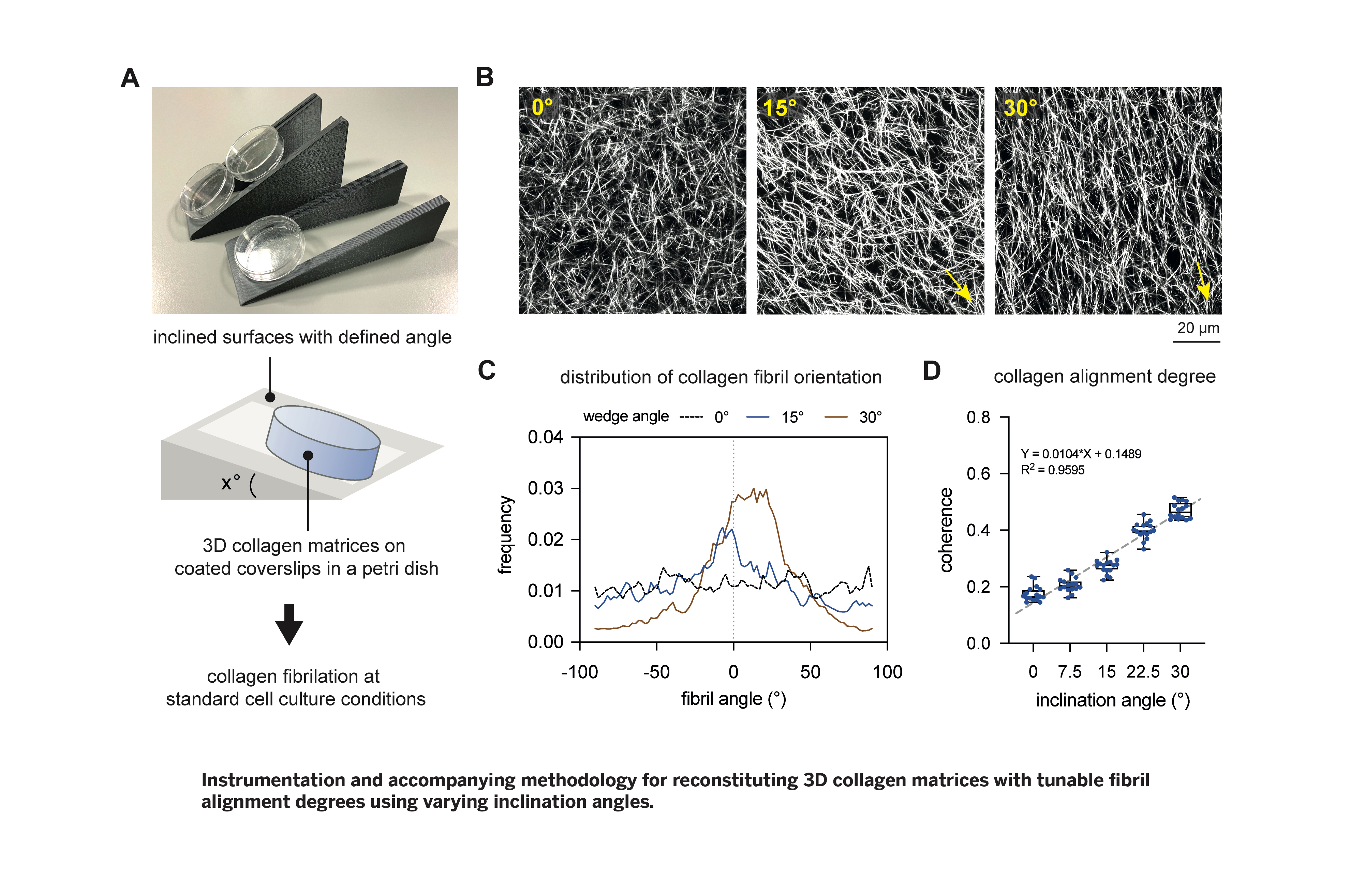Efficient and High-Throughput Tool to Engineer Aligned 3D Collagen Matrices for Tissue Culture

Unmet Need
Tunable, non-invasive, and high-throughput methods for tissue culture engineering
Technology
The Teo Laboratory at NYU Abu Dhabi has developed an efficient, inexpensive, and easy-to-use instrument and accompanying methodology for producing 3D collagen matrices with customizable fibril alignment levels for tissue culture applications. Unlike other conventional approaches, this innovative and simple instrument/ methodology leverages the inclination angle of a surface (0° to 30°) to drive collagen polymerization and alignment (see figure). As described in proof-of-concept work (Sapudom et al. Adv Si 2023), the inventors transferred unpolymerized collagen onto coverslips atop proprietary inclined surfaces and found the coherence index (CI) of collagen fiber alignment to be strongly correlated with the inclination angle (R2 = 0.9595), with the highest-tested angle (30°) giving the highest CI (0.47). In addition, they showed the reconstituted matrices to be highly reproducible by characterizing topological (mean pore and fibril diameter) and mechanical (elasticity) properties of the resulting compositions. In all, this instrument/method provides an elegant, inexpensive, and high-throughput means to reproducibly fabricate 3D collagen matrices with adjustable fibril CIs as biomimetic models of fibrotic tissue for various biomedical applications.
Background
The alignment of collagen fibrils is a hallmark of fibrotic tissues, which are associated with cancer, obesity-related diseases, chronic inflammation, and scarring. Collagen fibril alignment affects both tissue microarchitecture and its mechanical properties, which in turn, influence the pathological behavior of cells, such as fibroblasts, cancer cells, and macrophage subtypes. Concerns about ethics, cost, and the imperfect replication of human physiology have led to an increasing demand for alternative predictive culture models that adhere to the 3Rs principle of animal welfare: Replacement, Reduction, and Refinement. Current methods for creating aligned collagen matrices for tissue culture are invasive, low-throughput, and often require specialized equipment. Moreover, such methods may not faithfully recapitulate pathological tissues in vivo, hindering the ability to both (1) accurately study the diseased tissue of interest and (2) fully understand the role of collagen alignment in fibrosis progression. Therefore, innovative tissue culture engineering methods for aligning collagen fibrils are urgently needed; particularly, those that are non-invasive (e.g., no modification of collagen), high-throughput, inexpensive, and accessible to all scientists (i.e., don’t require specialized equipment/know-how).
Development Status
The instrument and accompanying methodology have been conceptualized, engineered (in the case of the instrument), and tested.
-
expand_more mode_edit Authors (1)Jeremy Teo, PhD
-
expand_more library_books References (1)
- Sapudom J, Karaman S, Quartey BC, Mohamed WKE, Mahtani N, Garcia-Sabaté A, Teo J. (May 30, 2023), Collagen Fibril Orientation Instructs Fibroblast Differentiation Via Cell Contractility
-
expand_more cloud_download Supporting documents (2)Product brochureEfficient and High-Throughput Tool to Engineer Aligned 3D Collagen Matrices for Tissue Culture.pdfMarketing BriefNYU - 3D collagen matrices for tissue culture - Marketing Brief - TEO01-01.pdf (527 KB)